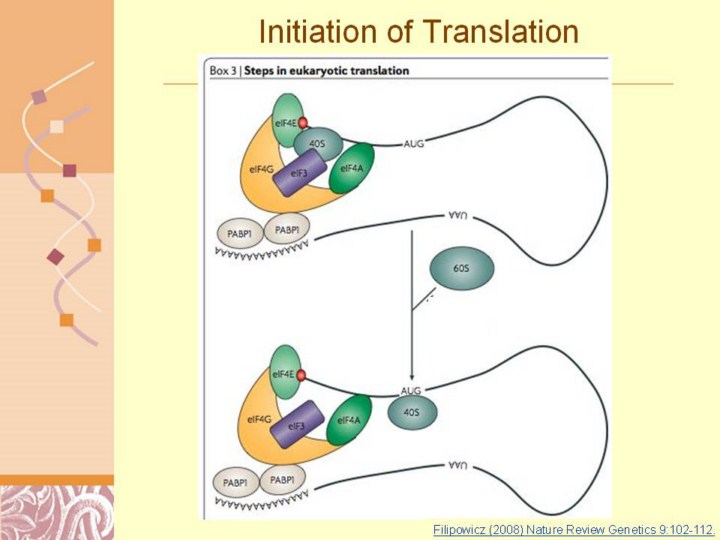| front |1 |2 |3 |4 |5 |6 |7 |8 |9 |10 |11 |12 |13 |14 |15 |16 |17 |18 |19 |20 |21 |22 |23 |24 |25 |26 |27 |28 |29 |30 |31 |32 |33 |34 |35 |36 |37 |38 |39 |40 |41 |42 |43 |44 |45 |review |
 |
Filipowicz (2008) Nature Review Genetics 9:102-112.
Translation of mRNA consists of three steps: initiation, elongation and termination. Initiation is the most complex step and is subject to a large number of interventions, with the phosphorylation of initiation factors being the key regulator133. Translation requires the participation of at least 10 initiation factors, many of them multi-subunit complexes38,39. Initiation of translation of most cellular mRNAs starts with the recognition of the mRNA 5′-terminal 7-methylguanosine (m7G) cap (represented by the red circle in the figure) by the eukaryotic translation initiation factor (eIF) 4E subunit of the initiation factor eIF4F, which also contains eIF4A (an RNA helicase) and eIF4G (a large multidomain protein that functions as scaffold for the assembly of the translation initiation complex). Interaction of eIF4G with another multi-subunit initiation factor, eIF3, facilitates the recruitment of the 40S subunit, which then begins scanning the mRNA 5′ UTR in search of the AUG (or in rare cases its cognate) initiation codon. Following the joining of the 60ribosomal subunit the elongation phase ensues. The elongation step can also be regulated by phosphorylation of the elongation factor eEF2 (Ref. 134). When the ribosome encounters a termination codon, translation release factors mediate the termination process, in which the ribosomal subunits dissociate from both the mRNA and from each other. An important function of eIF4G is its interaction with the poly(A)-binding protein 1, PABP1, which is associated with the poly(A) tail. This interaction brings about the circularization of the mRNA, which stimulates translation initiation and possibly recycling of ribosomes40,41. eIF6 is required for 60S subunit biogenesis, and might also act as an initiation factor that regulates subunit joining 58–61. Some cellular and many viral mRNAs initiate translation independently of the m7G cap and eIF4E, and sometimes also independently of other initiation factors. During this mode of translation, ribosomes are recruited to the mRNA through interaction with internal ribosome entry sites (IRES), which are usually highly structured regions in the 5′-UTR. The best-studied IRES are those of the encephalomyocarditis and polio viruses, hepatitis C virus and the insect crick paralysis virus. Bi-cistronic constructs, in which translation of the upstream cistron requires the presence of the cap and eIF4E and that of the downstream cistron requires internal initiation, are widely used as one of the means to identify a putative IRES38,42 (fIG. 1). Nature Reviews | Gene |